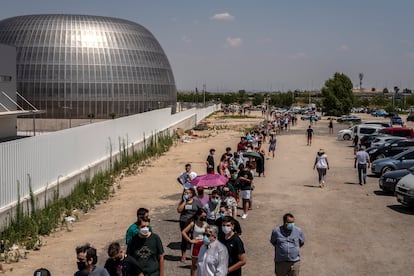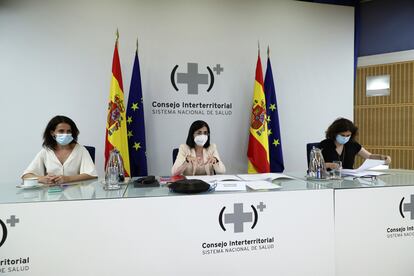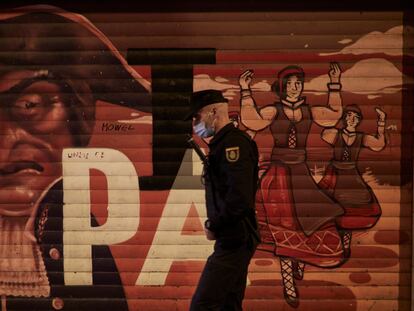During fifth coronavirus wave in Spain, 83% of new cases are among unvaccinated citizens
Infections are still rising, according to the latest ministry report, although the rate is starting to slow according to the health minister

Eighty-three percent of the new coronavirus cases that have been detected during the ongoing fifth wave of the pandemic in Spain are among unvaccinated citizens. That’s according to the health minister, Carolina Darias, who was speaking on Tuesday after a meeting of the Inter-Territorial Council of the National Health System (CISNS), which brings together the central Health Ministry and the regions. The latest spike in cases has seen the 14-day cumulative number of coronavirus cases per 100,000 inhabitants rise to 622, according to the latest ministry report, and has prompted hospitals to reopen wards to cope with the influx of patients.
“In the last five weeks, 5.5% [of infections registered] have been among the completely vaccinated and 11.4% among people with a single dose,” Darias explained on Tuesday. This data is an update on those she offered last week, when she stated that just 0.15% of those infected were fully vaccinated.
27,286 new cases reported
The Health Ministry reported 27,286 new coronavirus infections on Tuesday, and added 29 victims to the overall death toll. In total, there have been 4,189,136 cases detected in Spain since the health crisis began, and 81,148 people have died after testing positive for Covid-19.
The age group where infections are highest continues to be 20- to 29-year-olds. The cumulative incidence has risen among this group to 1,838 cases per 100,000 inhabitants in 14 days – 44 points up on Monday’s figure.
The cumulative incidence has risen in all regions, according to Tuesday’s report. Catalonia is the worst-affected territory, with 1,240 cases per 100,000 inhabitants in 14 days. In Navarre the figure is 905 cases, and in Castilla y León it is 910.
At the meeting, the representatives of the Health Ministry and the regions reviewed the current epidemiological situation in Spain. “The speed of the rise [in cases] has been slowing down over the last few days,” the minister explained, warning nonetheless that the “circulation of the virus continues to be high, meaning that we must continue with utmost prudence.”
Darias added that the rise in infections has also translated into an increase in hospital pressure, in particular for intensive care units, and has also overwhelmed the primary healthcare system given that many of these new infections are among younger people who either experience just mild symptoms or are asymptomatic. The minister, however, said that the rise in hospital admissions, which have been growing at a rate of 400 a day, is “gentle” compared to other waves of the pandemic, and pointed to the vaccine campaign as being the factor that has changed the nature of this latest spike.
The Inter-Territorial Council debated three issues related to the vaccines. The first was the availability of the next two vaccines that were due to be incorporated in Spain’s national strategy: Curevac and Novavax. There was bad news on this front, given that they “will not be available until the beginning of 2022,” according to sources with knowledge of the meeting on Tuesday.

The second was the proposal from five regions – Valencia, Aragón, Castilla y León, Madrid and Galicia – for the single-dose Janssen vaccine to be administered to the under-40s should they request it. The Health Ministry rejected this option on the basis that it had received a negative report from the board that is advising the government on the mass-vaccination strategy. Like the Oxford-AstraZeneca vaccine, the Janssen medication has been linked with some very rare cases of blood clotting in younger recipients, and as such has been limited for use among the over-40s in Spain.
The positive news yesterday was the increased number of doses that Spain is due to receive in the coming weeks. This week the figure will rise to 2.2 million – 1.7 million of which will be Pfizer-BioNTech shots. According to Darias, the biggest rise will be for the Moderna vaccine, which will go from “414,000 doses a week in July,” to “913,000 a week in August.”
EU Digital COVID Certificate
More than nine million people residing in Spain have already downloaded the European Union’s Digital COVID Certificate, which proves that they have been immunized against Covid-19. received a negative test result or recovered from the disease. Darias on Tuesday pointed to the advantages that this tool will mean for a return to mobility and added that “280,000 people” have already used the document when flying from one airport to another.
As for the home coronavirus testing kits that the government is planning on authorizing for sale in pharmacies, the minister insisted that positive cases detected via these diagnostics must also be confirmed by the regional health systems. But questioned further on this point, the minister was unable to confirm whether there will be some kind of process to ensure that those who test positive comply with this second requisite. The cost of these tests, which were previously not available without a prescription, will be between €6 and €10.
The Inter-Territorial Council has also agreed to compensate regions that have vaccinated people who do not reside in their territory by giving them additional vaccines. In total, the ministry is due to distribute 66,000 doses.
English version by Simon Hunter.
Tu suscripción se está usando en otro dispositivo
¿Quieres añadir otro usuario a tu suscripción?
Si continúas leyendo en este dispositivo, no se podrá leer en el otro.
FlechaTu suscripción se está usando en otro dispositivo y solo puedes acceder a EL PAÍS desde un dispositivo a la vez.
Si quieres compartir tu cuenta, cambia tu suscripción a la modalidad Premium, así podrás añadir otro usuario. Cada uno accederá con su propia cuenta de email, lo que os permitirá personalizar vuestra experiencia en EL PAÍS.
¿Tienes una suscripción de empresa? Accede aquí para contratar más cuentas.
En el caso de no saber quién está usando tu cuenta, te recomendamos cambiar tu contraseña aquí.
Si decides continuar compartiendo tu cuenta, este mensaje se mostrará en tu dispositivo y en el de la otra persona que está usando tu cuenta de forma indefinida, afectando a tu experiencia de lectura. Puedes consultar aquí los términos y condiciones de la suscripción digital.
More information

UK tourists return to Spain: flight bookings triple since change to quarantine rules
Últimas noticias
Most viewed
- Reinhard Genzel, Nobel laureate in physics: ‘One-minute videos will never give you the truth’
- Oona Chaplin: ‘I told James Cameron that I was living in a treehouse and starting a permaculture project with a friend’
- Pablo Escobar’s hippos: A serious environmental problem, 40 years on
- Why we lost the habit of sleeping in two segments and how that changed our sense of time
- Chevy Chase, the beloved comedian who was a monster off camera: ‘Not everyone hated him, just the people who’ve worked with him’










































